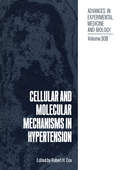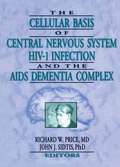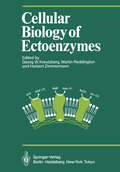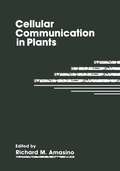- Table View
- List View
Cellular and Molecular Immunology E-Book: With Student Consult Online Access
by Abul K. Abbas Andrew H. Lichtman Shiv PillaiThe top required and recommended immunology text worldwide, Cellular and Molecular Immunology by Drs. Abul K. Abbas, Andrew H. H. Lichtman, and Shiv Pillai, is a clear, well-written, and superbly illustrated introduction to the field. The 9th Edition retains a practical, clinical focus while updating and revising all content to ensure clarity and comprehension, bringing readers fully up to date with new and emerging information in this challenging area.Highlights the implications of immunologic science for the management of human disease, emphasizing clinical relevance throughout. Provides a highly visual, full-color description of the key immunologic and molecular processes with a fully updated, comprehensive, and consistent art program. Helps readers grasp the details of experimental observations that form the basis for the science of immunology at the molecular, cellular, and whole-organism levels and draw the appropriate conclusions. Includes summary boxes that assist with rapid review and mastery of key material. Features updates from cover to cover, including tumor immunity (tumor antigens, cancer immunotherapy), immune checkpoints, cytosolic sensors for DNA, non-canonical inflammasomes, prionization as a signaling mechanism, monogenic defects in immunity, and more.
Cellular and Molecular Immunology E-Book: Cellular and Molecular Immunology E-Book
by Abul K. Abbas Andrew H. Lichtman Shiv PillaiWell-written, readable, and superbly illustrated, Cellular and Molecular Immunology, 10th Edition, continues the tradition of excellence established through multiple editions of this bestselling text. Offering an unparalleled introduction to this complex field, it retains a practical, clinical focus while updating and revising all content to ensure clarity and comprehension, bringing readers fully up to date with new and emerging information in this challenging area. It's an ideal resource for medical, graduate, and undergraduate students, as well as a trusted reference for physicians and scientists. - Highlights the implications of immunologic science for the management of human disease, emphasizing clinical relevance throughout. - Employs a highly accessible writing style that makes difficult concepts easier to understand, and provides clear implications of immunologic science to the management of human disease and clinical practice. - Features updates from cover to cover, including new information on intracellular sensors of innate immunity, therapeutic use of monoclonal antibodies, regulation of migration events during T cell-B cell interactions, regulatory and transcriptional events in germinal center formation, immunology of infectious diseases including coronaviruses, human immunodeficiency disorders, and immunology of HIV. - Provides a highly visual, full-color description of the key immunologic and molecular processes with a fully updated, comprehensive, and consistent art program, including many new and extensively revised illustrations. - Helps readers grasp the details of experimental observations that form the basis for the science of immunology at the molecular, cellular, and whole-organism levels and draw the appropriate conclusions. - Includes summary boxes that assist with rapid review and mastery of key material. - Evolve Instructor site with an image and test bank is available to instructors through their Elsevier sales rep or via request at https://evolve.elsevier.com.
Cellular and Molecular Mechanisms in Hypertension (Advances in Experimental Medicine and Biology #308)
by Robert H. CoxHypertension is recognized to be one of the major risk factors for the development of peripheral vascular disease. The last decade has witnessed several major advances in therapy for hypertension, including the development of angiotensin-converting enzyme inhibitors and calcium channel blockers. These compounds have greatly improved the ability to control blood pressure and to reduce the impact of this risk factor on morbidity and mortality. In spite of these advances, cardiovascular disease remains a major health problem in most modern industrialized countries with related deaths exceeding those from all other causes combined. In contrast to these advances in therapy, our understanding of the basic mechanisms responsible for the pathogenesis of hypertension remains incomplete. Recent studies have produced new insights into the nature of the regulation of muscle contraction in both heart and blood vessels as well as the changes in muscle function that occur in hypertension. However, the effects of antihypertensive therapy, both in terms of restoring normal function and in producing reversal of hypertension-associated changes, has not been as thoroughly studied, especially in the vasculature. Studies in the heart suggest that the efficacy of different therapeutic agents in restoring normal function and reversing hypertensive changes vary substantially with the mechanism of action of the therapeutic agent. It has also been recently determined that some therapeutic agents produce adverse effects on plasma lipid profiles, which could lead to the secondary acceleration of the atherosclerotic process, while at the same time normalizing blood pressure.
Cellular and Molecular Methods in Neuroscience Research
by Adalberto Merighi C. Cuello Giorgio CarmignotoThere are numerous books on cellular and molecular protocols for general use in cell biology but very few are exclusively devoted to neurobiology. This book fills this gap and explains in a clear and consistent manner, some of the more commonly used protocols in neuroscience research. Each chapter is written by either the person who invented the procedure or an expert in the field. The format is uniform: "Overview," "Background," "Protocols," and "results and discussion." Each protocol begins with the principle of the technique, studies in cell culture, materials and reagents, and, lastly, step-by-step outline of the procedure itself. This highly practical book is also well illustrated (with 17 four color plates) to make the concepts and procedures easy to understand and perform.
Cellular and Molecular Neurophysiology
by Constance HammondCellular and Molecular Neurophysiology, Third Edition, is the new, thoroughly revised edition of the only current, established, and authoritative text focusing on the cellular and molecular physiology of nerve cells. Previously titled Cellular and Molecular Neurobiology, the new title better reflects this focus. This version contains 80% new or updated material. Fifteen appendices describing neurobiological techniques are interspersed in the text. Now in full color throughout, the book has over 400 carefully selected and constructed illustrations. It includes an instructor website with all the images in electronic format, plus additional material. The book is hypothesis driven rather than just presenting the facts, and the content is firmly based on numerous experiments performed by the top experts in the field. While covering the important facts, the book also presents the background for how researchers arrived at this knowledge to provide a context for the field. It promotes a real understanding of the function of nerve cells that is useful for practicing neurophysiologists and students in a graduate-level course on the topic alike.* 80% new or updated material* Fifteen appendices describing neurobiological techniques are interspersed in the text* Now in full color throughout, with more than 400 carefully selected and constructed illustrations* Provides an instructor website with all the images in electronic format, plus additional material
Cellular and Molecular Neurophysiology
by Constance HammondCellular and Molecular Neurophysiology, Fourth Edition, is the only up-to-date textbook on the market that focuses on the molecular and cellular physiology of neurons and synapses. Hypothesis-driven rather than a dry presentation of the facts, the book promotes a real understanding of the function of nerve cells that is useful for practicing neurophysiologists and students in a graduate-level course on the topic alike. This new edition explains the molecular properties and functions of excitable cells in detail and teaches students how to construct and conduct intelligent research experiments. The content is firmly based on numerous experiments performed by top experts in the field This book will be a useful resource for neurophysiologists, neurobiologists, neurologists, and students taking graduate-level courses on neurophysiology. 70% new or updated material in full color throughout, with more than 350 carefully selected and constructed illustrationsFifteen appendices describing neurobiological techniques are interspersed in the text
Cellular and Molecular Regulation of Testicular Cells (Serono Symposia USA)
by Claude DesjardinsConceptual advances in the biological sciences are marked by the applica tion of new techniques and experimental strategies. Nowhere has this ge neric principle been more apparent than in the study of testicular cells, as judged by the evolution of themes presented at the Testis Workshop over the past 23 years. Like its predecessors, the 1995 Testis Workshop was structured to offer fresh insights and approaches for understanding the mechanisms of spermatogenesis and steroidogenesis. The chapters pre sented in this book emphasize three aspects of testicular cell function: first, the molecular analysis of the cell cycle; second, examination of the cell cycle, including the function and identification of specific macromolecules that direct the proliferation and differentiation of germ cells; and third, the development of Leydig cells and the role of specific macromolecules in the formation of testicular steroids. Each chapter is based on a lecture presented at the XIIIth Testis Work shop held on March 30 to April 1, 1995, at the Radisson Plaza Hotel in Raleigh, North Carolina. The selection of topics reflects the recommenda tions of the workshop'S organizing committee. Sincere thanks are due to the speakers who agreed to lecture and prepare chapters.
Cellular Aspects of Hypertension
by AlbericoBorghetti GiacomoBruschiIn the last two decades, investigations at the cellular level have progressively gained ground in the context of hypertension research. This choice of approach is due to some extent to the build up of know-how that molecular and cellular biology have been producing at a continuous rate. As the contents list of this volume shows, a large mass of work has been directed to gaining some insight into pathogenetic mechanisms. The pathogenesis of primary hypertension has been progressively categorized as a distinct biological problem, not amenable to the theoretical models that proved successful in understanding the nature of secondary forms of hypertension. At the same time, great efforts have been made to simplify this problem by sorting out, if possible, a few crucial mechanisms from the network of contributory factors in the regulation of blood pressure. The idea that what is to be sought is a primary structural and/or functional fault in arterial muscle has met with widespread acceptance. The strength of this argument lies in the fact that peripheral vascular resistance is increased in all forms of hypertension and, in turn, the diameter of resistance vessels is the dominant factor in the computation of total per ipheral resistance. On the basis of this, cardiovascular structural adaptation was proposed as a positive feedback mechanism tending to maintain hypertension, once begun, whatever the initiating factor is.
Cellular Aspects of Immunity (Novartis Foundation Symposia #902)
by G. E. W. Wolstenholme Maeve O'ConnorThe Novartis Foundation Series is a popular collection of the proceedings from Novartis Foundation Symposia, in which groups of leading scientists from a range of topics across biology, chemistry and medicine assembled to present papers and discuss results. The Novartis Foundation, originally known as the Ciba Foundation, is well known to scientists and clinicians around the world.
The Cellular Basis of Central Nervous System HIV-1 Infection and the AIDS Dementia Complex
by Richard W Price John J SidtisIn this exciting symposium, the editor brings to print important new information on AIDS and how HIV affects the brain. Each chapter focuses on one or more of the cell types that reside in or traffic through the central nervous system (CNS). Each of these cells is important to considerations of the pathogenesis of the CNS. Neurologists, AIDS physicians, and other professionals caring for AIDS patients will find that this “cell-based” view provides a unique perspective and that it will guide and stimulate future investigation of this clinically important and pathogenetically intriguing disorder. The editor also introduces some general considerations for therapeutic intervention of AIDS dementia complex (ADC).The contributors to The Cellular Basis of Central Nervous System HIV-1 Infection and the AIDS Dementia Complex deal with the cells and mechanisms involved in HIV-1 brain infection and the resultant ADC. Each author was asked to review the involvement of their assigned cells in CNS HIV-1 infection and how these cells might be involved in the pathology and process of brain injury associated with ADC. Readers will be enlightened on the functional roles of various cells and how these cells and mechanisms might fit into the broader picture of ADC pathogenesis.
The Cellular Basis of Central Nervous System HIV-1 Infection and the AIDS Dementia Complex
by Richard W Price John J SidtisIn this exciting symposium, the editor brings to print important new information on AIDS and how HIV affects the brain. Each chapter focuses on one or more of the cell types that reside in or traffic through the central nervous system (CNS). Each of these cells is important to considerations of the pathogenesis of the CNS. Neurologists, AIDS physicians, and other professionals caring for AIDS patients will find that this “cell-based” view provides a unique perspective and that it will guide and stimulate future investigation of this clinically important and pathogenetically intriguing disorder. The editor also introduces some general considerations for therapeutic intervention of AIDS dementia complex (ADC).The contributors to The Cellular Basis of Central Nervous System HIV-1 Infection and the AIDS Dementia Complex deal with the cells and mechanisms involved in HIV-1 brain infection and the resultant ADC. Each author was asked to review the involvement of their assigned cells in CNS HIV-1 infection and how these cells might be involved in the pathology and process of brain injury associated with ADC. Readers will be enlightened on the functional roles of various cells and how these cells and mechanisms might fit into the broader picture of ADC pathogenesis.
Cellular Biology and Pharmacology of the Placenta: Techniques and Applications (pdf) (Trophoblast Research)
by Richard MillerCellular Biology of Ectoenzymes: Proceedings of the International Erwin-Riesch-Symposium on Ectoenzymes May 1984 (Proceedings in Life Sciences)
by Georg W. Kreutzberg Martin Reddington Herbert ZimmermannCells do not normally live as single entities but are grouped together in specific functional and structural configurations in various tissues. Intra cellular mechanisms maintain cellular viability and provide the means necessary for their specific cellular functions. The interaction between cells is maintained by mechanisms involving extracellular signalling. Such extracellular mechanisms may include special properties of the cell surface which involve immediate cell contact, but may also represent mechanisms which act at a distance and are mediated via special secretions and/or re ceptors. Recent studies on cell-cell contact have tended to stress cell sur face components directly mediating cellular interactions; the extracellular medium as a metabolically active compartment has been rather neglected. However, it represents a vital medium through which cells communicate, being important in, for example, chemotaxis in primitive organisms, and in devel~ment and in the coordination of multiple functions in multi cellular 0 ganisms. It is not surprising, therefore, that a number of mole cular me anisms have developed together with increasing biological complexi during evolution. Two aspects of the extracellular space have received increasing attention in the last few years. First, several macro molecules such as collagen, laminin and fibronectin have been identified as components of an extracellular matrix giving a structural dimension to the extracellular compartment.
Cellular Biology of Myxovirus Infections (Novartis Foundation Symposia #961)
by Julie Knight G. E. W. WolstenholmeThe Novartis Foundation Series is a popular collection of the proceedings from Novartis Foundation Symposia, in which groups of leading scientists from a range of topics across biology, chemistry and medicine assembled to present papers and discuss results. The Novartis Foundation, originally known as the Ciba Foundation, is well known to scientists and clinicians around the world.
Cellular Biology of the Endoplasmic Reticulum (Progress in Molecular and Subcellular Biology #59)
by Luis B. Agellon Marek MichalakThis book provides a comprehensive overview of the biology of the endoplasmic reticulum (ER) and the associated ER proteins, it discusses their structure, function and signaling mechanisms in the cell and their role in disease. This book also offers insights into the practical aspects of research and demonstrates the use of non-mammalian models to study the structure and function of the ER. Written by leading experts in the field, the book enables readers to gain a thorough understanding of current ER biology. It is intended for scientists and clinical researchers working on the endoplasmic reticulum in all its various roles and facets in health and disease.
Cellular Cancer Markers (Contemporary Biomedicine #12)
by Carleton T. Garrett Stewart SellIn Cellular Cancer Markers leading pathologists and physicians review today's most promising cellular cancer markers, an important emerging class of prognostic markers that can be used in the clinical evaluation of cancer patients. The markers reviewed have been chosen because they are biologically relevant to the growth of cells and possess an accurate and reproducible assay for detection. They also are predictors of tumor behavior, are useful in making clinical decisions, and are cost effective. Cellular Cancer Markers provides a status report for markers of tumor cell activation, proliferation, and longevity that makes possible an informed judgment regarding the value of many newly proposed tumor markers. It also offers insight into the latest approaches to diagnosing cancer and an appreciation of how these marker-based tests can clarify the prognosis of cancer.
Cellular Cardiomyoplasty: Methods and Protocols (Methods in Molecular Biology #1036)
by Race L. KaoEmbryonic stem cells and adult stem cells are the two major types of stem cells that have been used for experimental and clinical studies. Embryonic stem cells are totipotent cells that have the capability to differentiate into any type of cell in the body. In Cellular Cardiomyoplasty: Methods and Protocols, expert researchers in the field detail many of the methods which are now commonly used to study cellular cardiomyoplasty. Methods and techniques described in this volume use only adult stem cells or adult progenitor cells.Written in the highly successful Methods in Molecular Biology series format, chapters include introductions to their respective topics, lists of the necessary materials and reagents, step-by-step, readily reproducible laboratory protocols, and key tips on troubleshooting and avoiding known pitfalls. Authoritative and Practical, Cellular Cardiomyoplasty: Methods and Protocols will benefit the cardiologist, cardiothoracic surgeons, biologist (cell, molecular, or structural), biochemist, and physiologist who are interested in understanding and treating damaged myocardium and failing heart.
Cellular Dedifferentiation and Regenerative Medicine
by Xiaobing Fu Andong Zhao Tian HuThis book focuses on the contribution of cell dedifferentiation to the regenerative process in all body systems, as well as its underlying molecular mechanisms and applications.The book is divided into four parts, the first of which addresses the history of cell dedifferentiation and regenerative medicine. In turn, Part II compares three routes by which cells change their phenotype: dedifferentiation, transdifferentiation, and reprogramming. Part III includes an extensive review of cell dedifferentiation events in all nine body systems for lower organisms and mammalians, respectively. The final part reviews the relationship between cell dedifferentiation and the development of cancer and several other diseases, while also outlining the prospects of and future research directions in cell dedifferentiation and regenerative medicine. The main purpose of the book is to underline the importance of cell dedifferentiation in stem cell and regenerative medicine by providing a systematical review of dedifferentiation in all body systems, together with the latest reliable evidence.
Cellular Drug Delivery: Principles and Practice
by SveinØie D. RobertLuAn authoritative and up-to-date survey of the fundamental principles, and practice of drug delivery at the cellular level. On the principles side, the authors discuss the broad spectrum of cellular delivery, ranging from coverage of cell-mediated immunity, gene delivery, and protein targeting, to cellular drug transport, cellular drug permeability, and a variety of carrier system related to targeted drug delivery. On the practice side, the authors focus on technological developments in cellular drug delivery, including novel formulations for the delivery of DNA and antisense oligonucleotides ,as well as drug targeting with immunoglobulin formulations and antibody-mediated approaches.
Cellular Effects of Heavy Metals
by Gaspar BanfalviThe term “heavy metals” is used as a group name of toxic metals and metalloids (semimetals) causing contaminations and ecotoxicity. In strict chemical sense the density of heavy metals is higher than 5 g/cm3. From biological point of view as microelements they can be divided into two major groups. a. For their physiological function organisms and cells require essential microelements such as iron, chromium (III), cobalt, copper, manganese, molidenium, zinc. b. The other group of heavy metals is toxic to the health or environment. Of highest concern are the emissions of As, Cd, Co, Cu, Hg, Mn, Ni, Pb, Sn, Tl. The toxicity of heavy metals is well known at organizational level, while less attention has been paid to their cellular effects. This book describes the toxicity of heavy metals on microorganisms, yeast, plant and animal cells. Other chapters of the book deal with their genotoxic, mutagenic and carcinogenic effects. The toxicity of several metals touch upon the aspects of environmental hazard, ecosystems and human health. Among the cellular responses of heavy metals irregularities in cellular mechanisms such as gene expression, protein folding, stress signaling pathways are among the most important ones. The final chapters deal with biosensors and removal of heavy metals. As everybody is eating, drinking and exposed to heavy metals on a daily basis, the spirit of the book will attract a wide audience.
Cellular Engineering and Cellular Therapies: Proceedings of the Twenty-Seventh International Symposium on Blood Transfusion, Groningen, Organized by the Sanquin Division Blood Bank North-East, Groningen (Developments in Hematology and Immunology #38)
by L. F. M. H.Leij C. Th. SmitSibingaWelcome to the City of Groningen, the center of the North of the Netherlands. Groningen is proud of the long lasting tradition of scientific symposia organised by the Sanquin Blood Bank. These Sanquin International Symposia on Blood Transfusion have become a true traditional event in Groningen, marking the early academic year and have contributed to the specific reputation of Groningen and its University in the scientific field of Transfusion Medicine. The growing tradition has also contributed to initiatives of both University, Province and the City of Groningen to bring science and industry together - BioMedCity Groningen. Such repu- tion does not just happen, but is the result of creative and scientific leadership, of vision and an open mind, to explore in a team spirit horizons. Groningen is particularly proud of this reputation thanks to its leadership, the Sanquin Blood Bank North-East. This year in particular the theme chosen some two years ago is extremely timely as it illustrates the activities and scientific interest of an integrated team which includes our regional Sanquin Blood Bank North-East and fits in the City initiatives within the concept of BioMedCity, Groningen.
Cellular Factors Involved in Early Steps of Retroviral Replication (Current Topics in Microbiology and Immunology #281)
by John A. T. YoungThe articles in this volume provide a comprehensive overview of our current understanding of the roles played by cellular factors in the early steps of retroviral replication. A better understanding of these functions will provide critical new insights into retrovirus-host cell interactions and is likely to prove useful for the future development of effective antiretroviral therapies.























